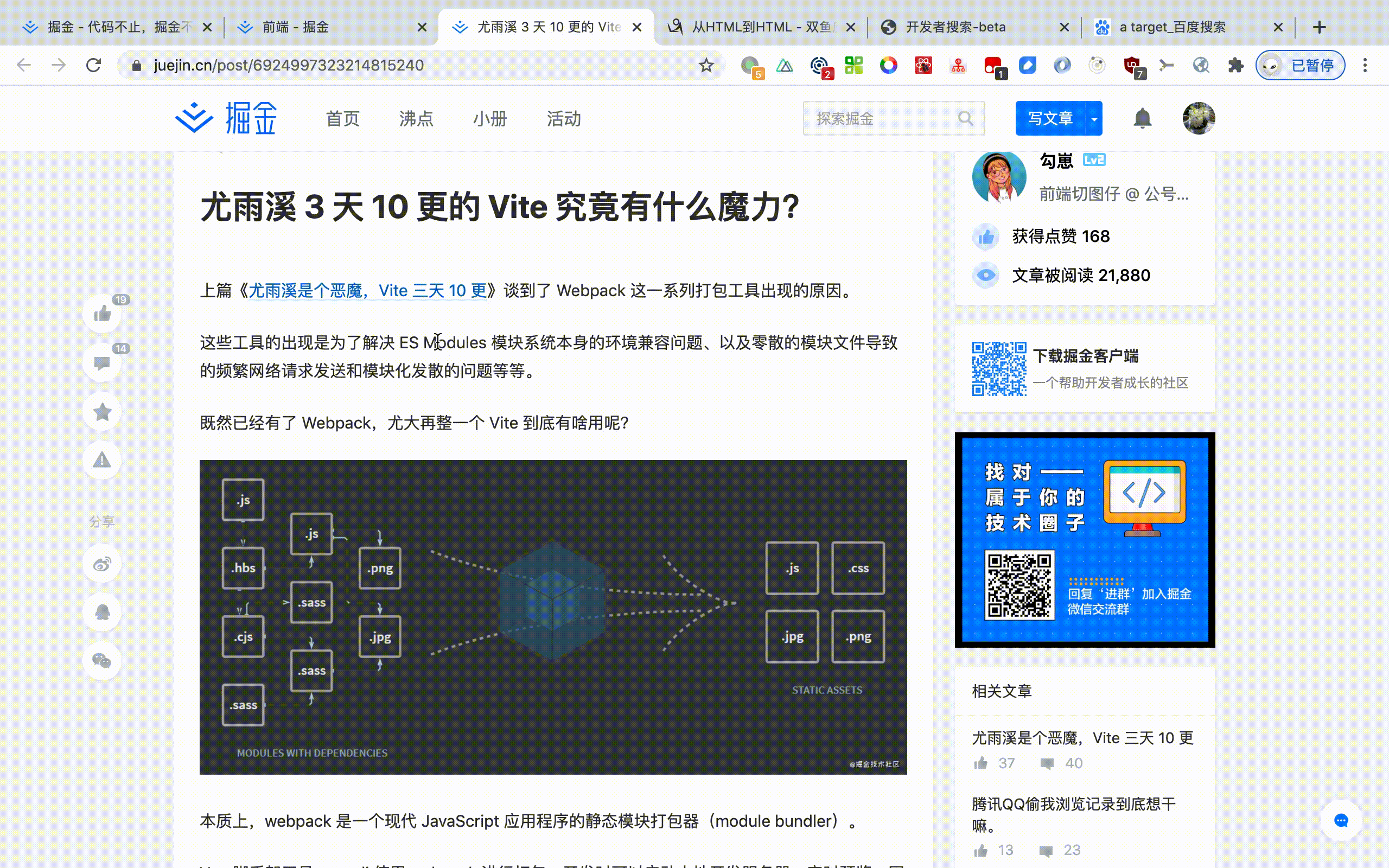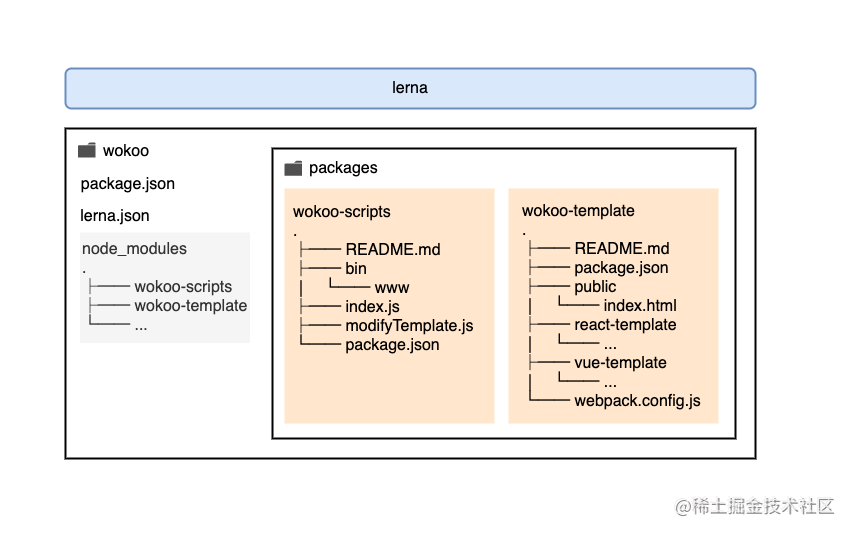油猴插件 & wokoo 脚手架使用说明
一款油猴插件的脚手架。如果直接开发油猴插件,开发者需要费时搭建 vue 或 react 基础项目,还需要对油猴脚本区域做对应的配置,开发体验差。
wokoo 可以一键式生成基础项目,并且提供基础 Tampermonkey 配置。主要提供的功能有:
- 命令行式创建脚手架初始项目
- 根据用户选择,生成 vue、react 的基本项目
- tampermonkey.js 文件中提供 Tampermonkey 配置
关于油猴插件和 wokoo 的具体使用可以阅读 5 分钟上手开发浏览器插件——油猴脚手架 wokoo
这里是 wokoo 脚手架代码:wokoo 脚手架 github 仓库
我使用 wokoo 开发了MoveSearch(划词搜索插件),欢迎大家使用

wokoo 脚手架的设计参考了create-react-app,我也曾经写过一篇分析 cra 源码的文章,感兴趣的同学可以阅读这篇 👉create-react-app 核心源码解读。
手把手教搭建过程
- lerna: 进行项目管理
- wokoo-scripts: 和用户交互,拉取 wokoo-template,生成对应的初始项目
- wokoo-template: 提供模板来初始化一个有基础配置的油猴项目。模板有两种:react 和 vue

- 安装 lerna
- 创建项目目录,初始化
1
2
3
| mkdir wokoo
cd wokoo
lerna init
|
- 开启 workspace,在 package.json 中增加
workspaces配置
1
2
3
| "workspaces": [
"packages/*"
],
|
- 创建子项目
1
2
| lerna create wokoo-scripts
lerna create wokoo-template
|
wokoo-scripts 编写
wokoo-scripts 的主要功能有:
- commander 获取 shell 中用户键入的 projectName
- fs.writeFile 创建文件路径
- 安装 wokoo-template 模板
- 读取模板指定后缀文件.md, .js,将 ejs 语法进行替换
- 删除多余内容
- 卸载模板
1.创建入口
进入packages/wokoo-scripts,创建bin/www文件
1
2
3
| #! /usr/bin/env node
require('../index.js')
|
修改 package.json,增加bin字段配置
1
2
3
| "bin": {
"wokoo": "./bin/www"
}
|
在 wokoo-scripts 下创建 index.js 文件作为项目入口。
2.安装依赖模块
介绍下用到的第三方模块:
安装依赖,添加软链
1
2
| npm install chalk cross-spawn commander fs-extra inquirer metalsmith consolidate ejs -S
npm link
|
3.实现 init 方法,读取命令行指令
主要使用commander来读取命令行中用户输入的项目名,此时在命令行执行wokoo my-app,能够在代码中获取到项目名 my-app
1
2
3
4
5
6
7
8
9
10
11
12
13
14
15
16
17
18
19
20
21
22
23
24
| const chalk = require('chalk')
const spawn = require('cross-spawn')
const { Command } = require('commander')
const fs = require('fs-extra')
const path = require('path')
const inquirer = require('inquirer')
const packageJson = require('./package.json')
let program = new Command()
init()
async function init() {
let projectName
program
.version(packageJson.version)
.arguments('<project-directory>')
.usage(`${chalk.green(`<project-directory>`)}`)
.action((name) => {
projectName = name
console.log('projectName:', projectName)
})
.parse(process.argv)
await createApp(projectName)
}
|
4.createApp 方法,根据项目名生成项目
在 run 方法中调 createApp 方法,传入 projectName。createApp 主要实现了创建文件夹,写入 package.json 的功能。
1
2
3
4
5
6
7
8
9
10
11
12
13
14
15
16
17
18
19
20
21
22
23
24
| async function createApp(appName) {
let root = path.resolve(appName)
fs.ensureDirSync(appName)
console.log(`create a new app in ${chalk.green(root)}`)
const packageJson = {
name: appName,
version: '0.0.1',
private: true,
scripts: {
start: 'cross-env NODE_ENV=development webpack serve',
build: 'webpack',
},
}
fs.writeFileSync(
path.join(root, 'package.json'),
JSON.stringify(packageJson, null, 2)
)
process.chdir(root)
await run(root, appName)
}
|
5. run:复制项目模板到当前项目下,生成基础项目
createApp 最后要调用 run 方法。run 主要做了以下几点 👇:
- 安装 wokoo-template
1
2
3
4
5
6
7
8
9
10
| const templateName = 'wokoo-template'
const allDependencies = [templateName]
console.log('Installing packages. This might take a couple of minutes')
console.log(`Installing ${chalk.cyan(templateName)} ...`)
try {
await doAction(root, allDependencies)
} catch (e) {
console.log(`Installing ${chalk.red(templateName)} failed ...`, e)
}
|
- 根据用户选择的模板类型复制相应模板文件到临时文件夹 temp,替换其中的 ejs 模板,然后删除临时文件夹 temp
1
2
3
4
5
6
7
8
9
10
11
12
13
14
15
16
17
18
19
20
21
22
23
24
25
26
27
28
29
30
31
32
33
34
35
36
37
38
|
const repos = ['vue', 'react']
const { targetTemplate } = await inquirer.prompt({
name: 'targetTemplate',
type: 'list',
message: 'which template do you prefer?',
choices: repos,
})
const templatePath = path.dirname(
require.resolve(`${templateName}/package.json`, { paths: [root] })
)
const scriptsConfigDir = path.join(templatePath, 'webpack.config.js')
const gitIgnoreDir = path.join(templatePath, '.npmignore')
const publicDir = path.join(templatePath, 'public')
const tempDir = path.join(root, 'temp')
const templateDir = path.join(templatePath, `${targetTemplate}-template`)
if (fs.existsSync(templatePath)) {
await modifyTemplate(templateDir, 'temp', {
projectName: appName,
basicProject: targetTemplate,
})
fs.copySync(tempDir, root)
fs.copySync(publicDir, root + '/public')
fs.copyFileSync(scriptsConfigDir, root + '/webpack.config.js')
fs.copyFileSync(gitIgnoreDir, root + '/.gitignore')
deleteFolder(tempDir)
} else {
console.error(
`Could not locate supplied template: ${chalk.green(templatePath)}`
)
return
}
|
此处,我将复制的功能封装到 modifyTemplate.js 中。利用 MetalSmith 提供的方法遍历源路径下文件,利用 consolidate.ejs 将文件中的 ejs 语法替换后,将内容写入新的临时文件夹 temp 中。
1
2
3
4
5
6
7
8
9
10
11
12
13
14
15
16
17
18
19
20
21
22
23
24
25
26
27
28
29
30
31
32
33
34
35
36
37
38
39
40
41
42
43
44
45
46
47
48
49
50
51
52
53
54
55
56
57
58
| const MetalSmith = require('metalsmith')
let { render } = require('consolidate').ejs
const { promisify } = require('util')
const path = require('path')
render = promisify(render)
async function handleTemplate(fromPath, toPath, config) {
await new Promise((resovle, reject) => {
MetalSmith(__dirname)
.source(fromPath)
.destination(path.join(path.resolve(), toPath))
.use(async (files, metal, done) => {
let result = {
license: 'MIT',
version: '0.0.1',
...config,
}
const data = metal.metadata()
Object.assign(data, result)
done()
})
.use((files, metal, done) => {
Reflect.ownKeys(files).forEach(async (file) => {
let content = files[file].contents.toString()
if (
file.includes('.js') ||
file.includes('.json') ||
file.includes('.txt') ||
file.includes('.md')
) {
if (content.includes('<%')) {
content = await render(content, metal.metadata())
files[file].contents = Buffer.from(content)
}
}
})
done()
})
.build((err) => {
if (!err) {
resovle()
} else {
reject(err)
}
})
})
}
module.exports = handleTemplate
|
- 合并 template.json 和 package.json,生成新的 package.json 并再次执行
npm install
1
2
3
4
5
6
7
8
9
10
11
12
13
14
15
16
17
18
19
20
21
22
23
24
25
26
27
28
29
30
31
32
33
34
35
|
let tempPkg = fs.readFileSync(root + '/template.json').toString()
let pkg = fs.readFileSync(root + '/package.json').toString()
const tempPkgJson = JSON.parse(tempPkg)
const pkgJson = JSON.parse(pkg)
pkgJson.dependencies = {
...pkgJson.dependencies,
...tempPkgJson.package.dependencies,
}
pkgJson.devDependencies = {
...tempPkgJson.package.devDependencies,
}
fs.writeFileSync(
path.join(root, 'package.json'),
JSON.stringify(pkgJson, null, 2)
)
fs.unlinkSync(path.join(root, 'template.json'))
const dependenciesToInstall = Object.entries({
...pkgJson.dependencies,
...pkgJson.devDependencies,
})
let newDependencies = []
if (dependenciesToInstall.length) {
newDependencies = newDependencies.concat(
dependenciesToInstall.map(([dependency, version]) => {
return `${dependency}@${version}`
})
)
}
await doAction(root, newDependencies)
console.log(`${chalk.cyan('Installing succeed!')}`)
|
- 卸载 wokoo-template
1
| await doAction(root, 'wokoo-template', 'uninstall')
|
流程上的实现介绍完了,下面两个方法是我封装的功能性方法
doAction:使用 npm 安装或卸载项目依赖
使用cross-spawn开启子线程,在子线程中执行npm install 或 npm uninstall的命令
1
2
3
4
5
6
7
8
9
10
11
12
13
14
15
16
17
18
19
20
| async function doAction(root, allDependencies, action = 'install') {
typeof allDependencies === 'string'
? (allDependencies = [allDependencies])
: null
return new Promise((resolve) => {
const command = 'npm'
const args = [
action,
'--save',
'--save-exact',
'--loglevel',
'error',
...allDependencies,
'--cwd',
root,
]
const child = spawn(command, args, { stdio: 'inherit' })
child.on('close', resolve)
})
}
|
deleteFolder: 递归删除文件、文件夹,入参是 path 文件路径
1
2
3
4
5
6
7
8
9
10
11
12
13
14
15
16
17
| function deleteFolder(path) {
let files = []
if (fs.existsSync(path)) {
if (!fs.statSync(path).isDirectory()) {
fs.unlinkSync(path)
} else {
files = fs.readdirSync(path)
files.forEach(function (file) {
let curPath = path + '/' + file
deleteFolder(curPath)
})
fs.rmdirSync(path)
}
}
}
|
wokoo-template 编写
- 分为 vue-template 和 react-template
- vue-template 和 react-template 分别对应 webpack 配置的一个 vue 或 react 基础项目
- 使用 ejs 模板,实现 wokoo-scripts 注入变量
template 相对来说比较简单,使用 webpack+vue 或 react 分别搭建了一个轻量级项目。
具体代码可看 👉wokoo/wokoo-template
发布
在执行lerna publish之前,先看下自己的项目下用到的文件或文件夹是否在 package.json files字段中。只有在 files 中的文件或文件夹才会真正的被发布上去。
- 在 wokoo-scripts 的 package.json 的
files字段中增加”modifyTemplate.js”
- 在 wokoo-template 的 package.json 的
files字段中增加”react-template”, “vue-template”,”public”,”webpack.config.js”,”.gitignore”
我之前就忘记往 files 字段添加,导致 publish 上去后发现丢文件了。具有问题可阅读:https://stackoverflow.com/questions/27049192/npm-publish-isnt-including-all-my-files
最后一步就大功告成了!🎉
使用
1
2
| npm i wokoo -g
wokoo my-app
|
具体使用过程可以阅读油猴脚手架 wokoo 使用说明
都读到这里了,给你鼓个掌吧 👏👏👏